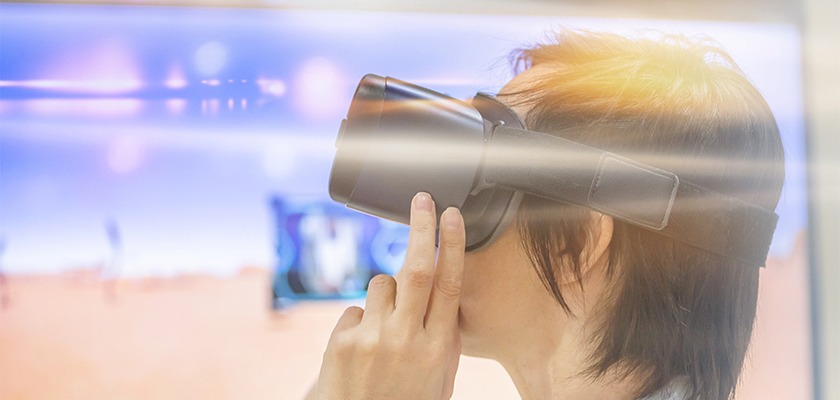Imagine that you are shopping for clothes. One vendor requires you to visit in person to try out umpteen (sanitized?) options. And the other uses technology to let you see the “after look” and even place the order online once you have chosen. Who is more likely to get your money? Virtual marketing is here!
Now imagine you are selling an advanced augmented reality (AR) solution that helps the surgeon take care of a tricky situation without damaging healthy tissue. Or a wheelchair that can be customized to the user for maximum mobility with minimum discomfort. Are you likely to make much headway if you try to market these using a slide-set? Or a huge hoarding? Or any of the traditional routes?
Technology marches on, marketing must keep up
What if the only way you can communicate with your computer is by using the keyboard? You have no option but to remember a series of keyboard combinations (the ^C+^V kind). That changed in 1964 when Douglas Engelbart put together a wooden shell, two wheels and a circuit board, and created the first mouse. Eight years later came the “ball mouse” and in 1998 the now-common optical mouse took over the market.
Today, the only mouse that gets a second look is the one that squeaks and comes with a furry tail. And the digital version needs no marketing.
What marketing needs is the technology of the AR and virtual reality (VR) kind, that has blurred the distinction between science fiction and modern reality. Believing is no longer about seeing but about experiencing.
As Wim Crooijmans puts it, “a new brand of healthcare is emerging which uses large amounts of medical data to build more immersive, visualization tools to support diagnosis and treatment.”
He points out how AR/VR can create a digital twin to work or practice on without putting the flesh-and-blood version at risk. The technology is “immensely powerful and the value creation can be four-fold: shorter procedure times; better clinical outcomes; better prediction and execution of the procedure; and, more intuitive and comfortable experience for staff.”
The opportunity to experience is the best way to convince potential users and the decision-makers to invest in such technology or device. As technology marches on, it is the responsibility of the marketing team to stay abreast to inform and help those who save and improve lives.
As the market thrives, marketing holds the key
According to BIS Research, “the market for virtual reality and augmented reality in healthcare was estimated around $2.14 billion in 2018 and is projected to reach $11.14 billion by 2025. The market is anticipated to grow at a CAGR of 23.13%, during the forecast period from 2018-2025.”
The report notes that the technologies have been “used for applications for patient experience, therapeutics, training, drug store executives, and medical procedures.” The growth rate is expected to remain robust in pace with the rapid digitization of the healthcare sector, fueled by investments from prominent companies.
How will the pandemic and the lockdown affect growth? Given the heightened awareness about health and the desperate need for quick, remote training of skilled staff, the AR/VR industry is expected to accelerate.

Nathan Pettyjohn, Commercial AR/VR Lead at Lenovo, expects a few different AR/VR use cases to become more normal. “One is the remote-assistance scenario. Another is guided workflow, where you see work instructions in AR in front of you in a hands-free environment. Another is retraining, or re-skilling the workforce.”
Kalyan Sridhar, SVP and Country Manager – India, PTC opines that “in this kind of COVID situation, medical device manufacturers and many healthcare organizations are short of skilled workers. Through AR, the training and knowledge transfer can be done in a faster and smarter way.” He observes that the entire medical equipment manufacturing industry has diversified itself and is turning this situation into an opportunity by strengthening supply chain management and refocusing on R&D.
Vipul Jain, CEO of Advancells, is confident that “the dependence on healthcare technological solutions will keep on increasing at a pace and scale we have not seen so far. This has numerous potential outcomes. From diagnosing illness at home to the customized care of patients post release from hospitals and giving advice/reminders over video conferencing, everything will change.”
As technology races on and gets more complex, and as more players enter the market, it becomes crucial for marketing to step up the game. They need to use the very same technologies to present a convincing case and win the day.
Iron Man entertains, Tony needs good health
It was the technology that transformed Tony Stark into the fictional flying, fighting hero, Iron Man. In fact, both AR and VR had their origins in the gaming and entertainment world.
However, fiction stops and reality begins when a medical student uses the technology to visualize a tumor in the brain and practices excising it. One day, as a full-fledged neurosurgeon, she will go on to use the same (or even more advanced) technology to visualize and plan around dangers not revealed by conventional imaging.
Today, designers work in 3D. They shape wonderful devices that save and improve the quality of life. Brandon Bogdalek is happy that AR and VR help designers to place things in perspective, in relation to human anatomy. A new device is easier to use if there is no need to turn to a manual and instructions appear on the heads-up display. Surgeons acquire lifesaving x-ray vision when they can enter CT or MRI data into a mixed reality headset and overlay patient-specific anatomy.
Technology is what technology does. For the marketers of medical technology and devices, it is about curing and caring. You need to help your potential customers to relate to your wonderful technology at a human level. They have the knowledge, they have seen enough, they have heard enough. Now you must let them “experience” what you would like them to invest in. For that, you must use the very technology that has created your product or technology.
Just as the proof of the pudding is in the eating, the proof of AR/VR technology is in the experiencing.
Ethosh Digital offers end-to-end communication solutions for marketing modern medical devices and technology. Operating at the dynamic intersection of communication and technology, Ethosh specializes in the use of augmented reality and virtual marketing for telling immersive stories.


